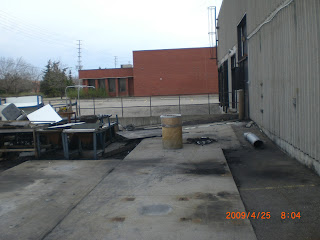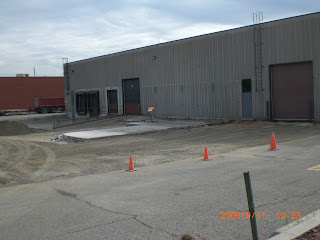
It's funny when you dig up some old pictures, and it makes you reflect on the events that led up to it, no matter how innocuous it may appear to be. The above image is a perfect example, taken of the back side of a business that had been recently shut down at the time.
There are apparently five shipping doors, consisting of three loading docks and two drive-in bays. However, only two of them were functionally available, being the two left-hand docks. Why was the operation constricted to only 40% of its potential shipping/receiving capacity? The first clue pops out when you take a closer look at the driveway under bay 3:

You have to look a bit closely, but there are spikes of rebar sticking out of the concrete, which served to secure a large dumpster that was seemingly always stationed under the bay door.
Bay 4's door was integrated into a large cardboard compactor that was inside, and thus could not be opened at all. In addition, a significant amount of garbage was left outside, which was one of the reasons the space between bays 4 and 5 was cluttered:

From the colour of the asphalt, it is readily apparently that the dust collection system inside (which was piped through a hole bored through the door next to bay 5) was not very efficient in collecting particulate matter, which engendered a completely different round of issues.
Between bays 4 and 5, a concrete pad was placed into the asphalt, on which an external dust collection system was mounted:


The bollards were steel tubes driven into the asphalt, into which concrete was poured. There was a secondary concrete pad poured between the first pad and the building.
The worst damage of all is seen at bay 5:



In this area are bollards, remnants of the same, as well as rebar punched into the asphalt. The upside-down T-bar at the top of the door also served to restrict the height of whatever could enter the building. In addition, there was a sorting line just inside the door, which prevented most equipment from being able to enter in any case. The shelter just in front of the door, which was used by maintenance staff for doing some outside work, did not help either.
The building had to be returned to the landlord at the end of its lease, which was only months away. The lease had a standard term, under which it had to be returned in the condition existing at the beginning of the term, and the changes undertaken by the tenant without the landlord's consent (including the above), known as "dilapidations", had to be removed. I was hired to help monitor the activity that needed to be done to fix all this. There was other work that needed to be done inside, but that is another story altogether!
The bay doors had to either repaired or replaced, to bring them back to working order. The asphalt in the back required substantial replacement, and the contractors really went to town on that:



And it really felt good to see the finished result:

But it does beg many questions as to what led to such a poorly designed system such as this. Several factors are quite apparent:
- The building is ideally designed to function as a warehouse. However, the business was oriented towards manufacturing, which has its own unique requirements.
- The business was being strangled by its waste collection system. The driveways on either side leading to the front of the building were very narrow, and thus any collection equipment could not be installed there. In addition, no thought was ever focused on using the space between bays 4 and 5 more efficiently with equipment positioned directly on the wall.
- With logistical capacity at only 40% of what it could have been, material flows both into and out of the facility were needlessly restricted. This had knock-on effects all down the line, which led to the loss of significant contracts with major customers arising from the inability to provide timely shipments.
